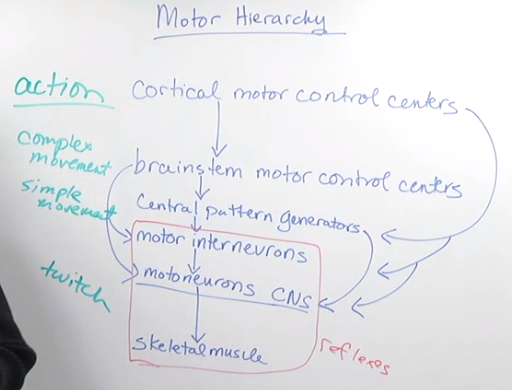III. Classification of Voluntary Movements (Continued):
- Reflexes:
- Defined by:
- Involuntary responses to stimuli.
- Not requiring conscious thought or intention.
- Examples:
- Knee jerk reflex
- Withdrawal reflex from hot objects
- Stumble reflex
- Occur at lower levels of the motor hierarchy without needing the brain.
- Involve motor neurons stimulating skeletal muscles for contraction.
- Defined by:
Stereotyped Automatic Movements:
- Defined by:
- Repetitive, learned movements performed frequently.
- Examples:
- Chewing
- Walking
- Running
- Standing
- Vomiting (though less frequent)
- Produced by central pattern generators (CPGs) in the spinal cord and brainstem.
- CPGs are neural circuits that generate rhythmic patterns without extensive cortical input.
Movements of Self-Expression:
- Defined by:
- Intentional and purposeful movements.
- Driven by the cortical motor control centers.
- Examples:
- Reaching
- Talking
- Fine motor skills (picking food out of teeth, writing)
- Dancing
Motor Hierarchy:
-
The lecture introduces the concept of the motor hierarchy, a layered system controlling movement complexity.
- Lower levels (motor neurons and spinal cord) generate basic movements.
- Higher levels (brainstem and cortex) add complexity, intention, and meaning.
-
A simple twitch is produced by motor neuron excitation.
-
Central pattern generators create basic rhythmic movements.
-
Brainstem motor control centers enable more complex movements like walking and posture.
-
Cortical motor control centers are responsible for intentional movements with meaning and purpose.
-
Neocortex involvement imbues movement with intention and transforms it into action.
 Key Points:
Key Points: -
Reflexes, stereotyped movements, and movements of self-expression are distinct categories based on control level and intentionality.
-
The motor hierarchy plays a crucial role in coordinating movement complexity.
-
Cortical involvement adds meaning and purpose to movement, transforming it into action.
Note:
- This section expands on the three movement categories and introduces the motor hierarchy concept.